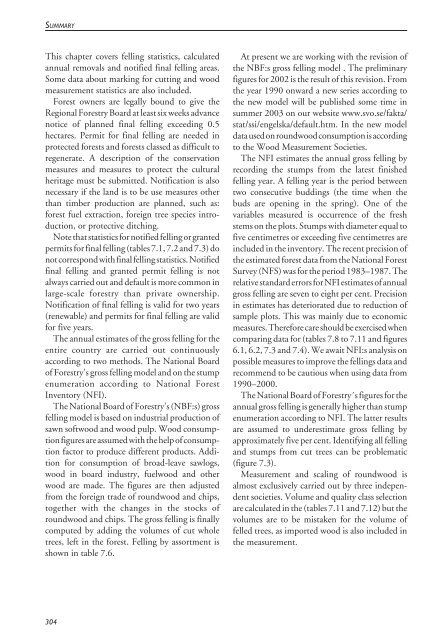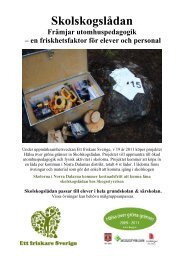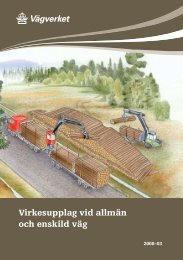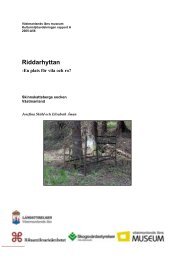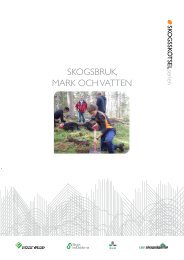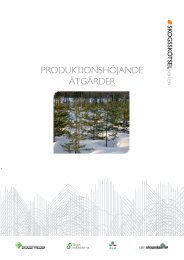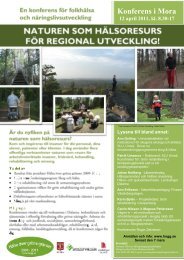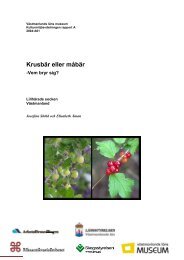Skogsstatistisk årsbok 2003.pdf - Skogsstyrelsen
Skogsstatistisk årsbok 2003.pdf - Skogsstyrelsen
Skogsstatistisk årsbok 2003.pdf - Skogsstyrelsen
- No tags were found...
Create successful ePaper yourself
Turn your PDF publications into a flip-book with our unique Google optimized e-Paper software.
SUMMARYThis chapter covers felling statistics, calculatedannual removals and notified final felling areas.Some data about marking for cutting and woodmeasurement statistics are also included.Forest owners are legally bound to give theRegional Forestry Board at least six weeks advancenotice of planned final felling exceeding 0.5hectares. Permit for final felling are needed inprotected forests and forests classed as difficult toregenerate. A description of the conservationmeasures and measures to protect the culturalheritage must be submitted. Notification is alsonecessary if the land is to be use measures otherthan timber production are planned, such as:forest fuel extraction, foreign tree species introduction,or protective ditching.Note that statistics for notified felling or grantedpermits for final felling (tables 7.1, 7.2 and 7.3) donot correspond with final felling statistics. Notifiedfinal felling and granted permit felling is notalways carried out and default is more common inlarge-scale forestry than private ownership.Notification of final felling is valid for two years(renewable) and permits for final felling are validfor five years.The annual estimates of the gross felling for theentire country are carried out continuouslyaccording to two methods. The National Boardof Forestry’s gross felling model and on the stumpenumeration according to National ForestInventory (NFI).The National Board of Forestry’s (NBF:s) grossfelling model is based on industrial production ofsawn softwood and wood pulp. Wood consumptionfigures are assumed with the help of consumptionfactor to produce different products. Additionfor consumption of broad-leave sawlogs,wood in board industry, fuelwood and otherwood are made. The figures are then adjustedfrom the foreign trade of roundwood and chips,together with the changes in the stocks ofroundwood and chips. The gross felling is finallycomputed by adding the volumes of cut wholetrees, left in the forest. Felling by assortment isshown in table 7.6.At present we are working with the revision ofthe NBF:s gross felling model . The preliminaryfigures for 2002 is the result of this revision. Fromthe year 1990 onward a new series according tothe new model will be published some time insummer 2003 on our website www.svo.se/fakta/stat/ssi/engelska/default.htm. In the new modeldata used on roundwood consumption is accordingto the Wood Measurement Societies.The NFI estimates the annual gross felling byrecording the stumps from the latest finishedfelling year. A felling year is the period betweentwo consecutive buddings (the time when thebuds are opening in the spring). One of thevariables measured is occurrence of the freshstems on the plots. Stumps with diameter equal tofive centimetres or exceeding five centimetres areincluded in the inventory. The recent precision ofthe estimated forest data from the National ForestSurvey (NFS) was for the period 1983–1987. Therelative standard errors for NFI estimates of annualgross felling are seven to eight per cent. Precisionin estimates has deteriorated due to reduction ofsample plots. This was mainly due to economicmeasures. Therefore care should be exercised whencomparing data for (tables 7.8 to 7.11 and figures6.1, 6.2, 7.3 and 7.4). We await NFI:s analysis onpossible measures to improve the fellings data andrecommend to be cautious when using data from1990–2000.The National Board of Forestry´s figures for theannual gross felling is generally higher than stumpenumeration according to NFI. The latter resultsare assumed to underestimate gross felling byapproximately five per cent. Identifying all fellingand stumps from cut trees can be problematic(figure 7.3).Measurement and scaling of roundwood isalmost exclusively carried out by three independentsocieties. Volume and quality class selectionare calculated in the (tables 7.11 and 7.12) but thevolumes are to be mistaken for the volume offelled trees, as imported wood is also included inthe measurement.304


